标签:test ringbuf cep 支持 integer info extends bool ted
初步掌握UML建模
了解设计模式
单元测试
(1)三种代码
伪代码是一种算法描述语言,结构清晰、代码简单、可读性好,并且类似自然语言, 不用拘泥于具体实现
百分制转五分制:
如果成绩小于60,转成“不及格”
如果成绩在60与70之间,转成“及格”
如果成绩在70与80之间,转成“中等”
如果成绩在80与90之间,转成“良好”
如果成绩在90与100之间,转成“优秀”
其他,转成“错误“public class MyUtil{
public static String percentage2fivegrade(int grade){
//如果成绩小于0,转成“错误”
if ((grade < 0))
return "错误";
//如果成绩小于60,转成“不及格”
else if (grade < 60)
return "不及格";
//如果成绩在60与70之间,转成“及格”
else if (grade < 70)
return "及格";
//如果成绩在70与80之间,转成“中等”
else if (grade < 80)
return "中等";
//如果成绩在80与90之间,转成“良好”
else if (grade < 90)
return "良好";
//如果成绩在90与100之间,转成“优秀”
else if (grade <= 100)
return "优秀";
//如果成绩大于100,转成“错误”
else
return "错误";
}
}
写了产品代码,我们还要写测试代码,证明自己的代码没有问题。
import org.junit.Test;
import junit.framework.TestCase;
public class MyUtilTest extends TestCase {
@Test
public void testNormal() {
assertEquals("不及格", MyUtil.percentage2fivegrade(55));
assertEquals("及格", MyUtil.percentage2fivegrade(65));
assertEquals("中等", MyUtil.percentage2fivegrade(75));
assertEquals("良好", MyUtil.percentage2fivegrade(85));
assertEquals("优秀", MyUtil.percentage2fivegrade(95));
}
@Test
public void testExceptions() {
assertEquals("错误", MyUtil.percentage2fivegrade(105));
assertEquals("错误", MyUtil.percentage2fivegrade(-55));
}
@Test
public void testBoundary() {
assertEquals("不及格", MyUtil.percentage2fivegrade(0));
assertEquals("及格", MyUtil.percentage2fivegrade(60));
assertEquals("中等", MyUtil.percentage2fivegrade(70));
assertEquals("良好", MyUtil.percentage2fivegrade(80));
assertEquals("优秀", MyUtil.percentage2fivegrade(90));
assertEquals("优秀", MyUtil.percentage2fivegrade(100));
}
}
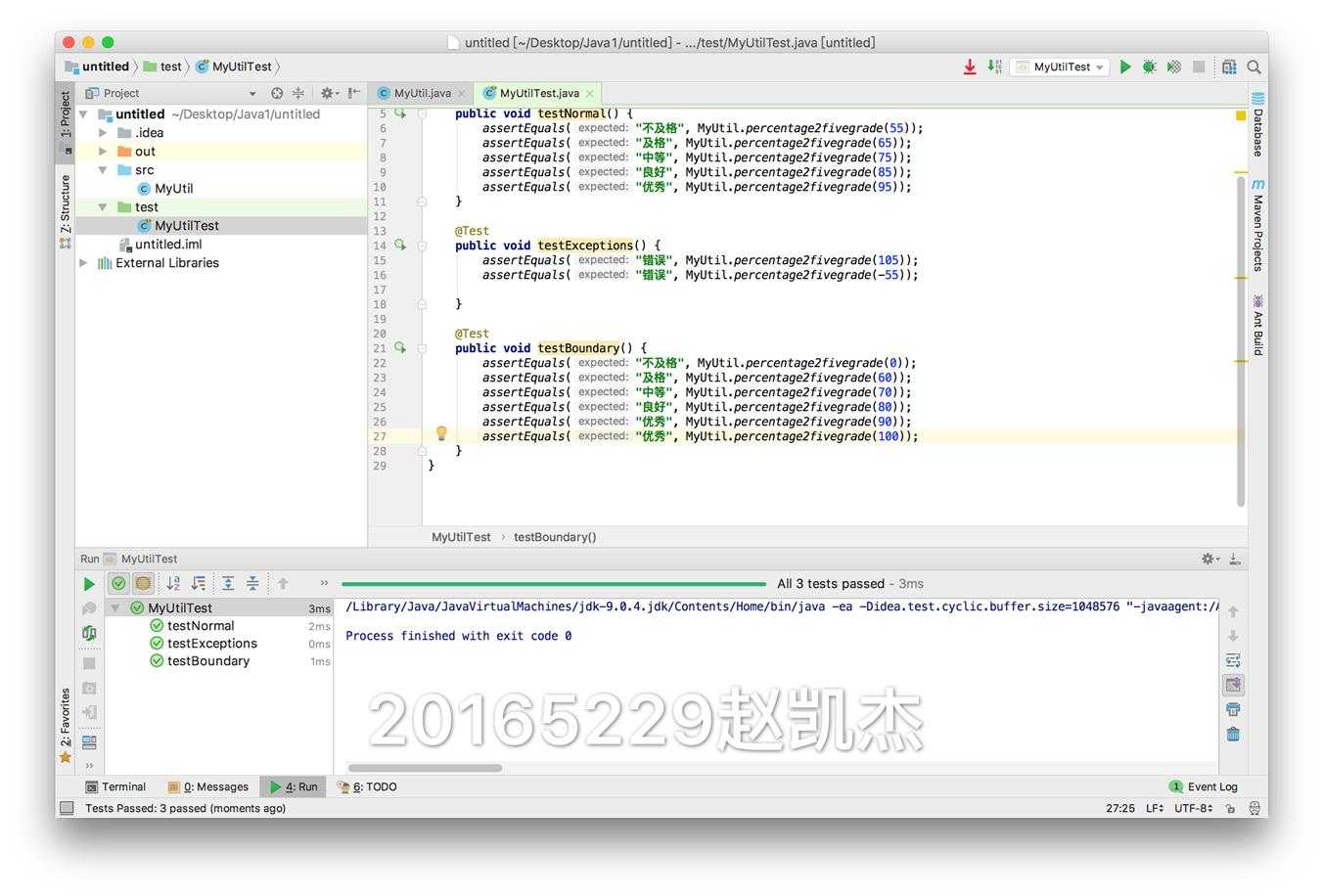
TDD(Test Driven Devlopment, 测试驱动开发)
TDD的一般步骤如下:
明确当前要完成的功能,记录成一个测试列表
快速完成编写针对此功能的测试用例
测试代码编译不通过(没产品代码呢)
编写产品代码
测试通过
对代码进行重构,并保证测试通过(重构下次实验练习)
循环完成所有功能的开发
以 TDD的方式研究学习StringBuffer
根据老师给的代码,进行对Junit的应用。
产品代码
public class StringBufferDemo{
private StringBuffer buffer = new StringBuffer();
public StringBufferDemo(StringBuffer buffer){
this.buffer = buffer;
}
public Character charAt(int i){
return buffer.charAt(i);
}
public int capacity(){
return buffer.capacity();
}
public int length(){
return buffer.length();
}
public int indexOf(String buf) {
return buffer.indexOf(buf);
}
}测试代码
import junit.framework.TestCase;
import org.junit.Test;
public class ComplexTest extends TestCase {
Complex a = new Complex( 0,3);
Complex b= new Complex( -1,-1);
@Test
public void testComplexAdd () throws Exception {
assertEquals( "-1.0+2.0i",a.ComplexAdd(b).toString());
}
@Test
public void testComplexSub () throws Exception{
assertEquals( "1.0+4.0i",a.ComplexSub(b).toString());
}
@Test
public void testComplexMulti () throws Exception {
assertEquals( "3.0 -3.0i",a.ComplexMulti(b).toString());
}
@Test
public void testComplexDiv () throws Exception {
assertEquals( "-1.5 -1.5i",a.ComplexDiv(b).toString());
}
}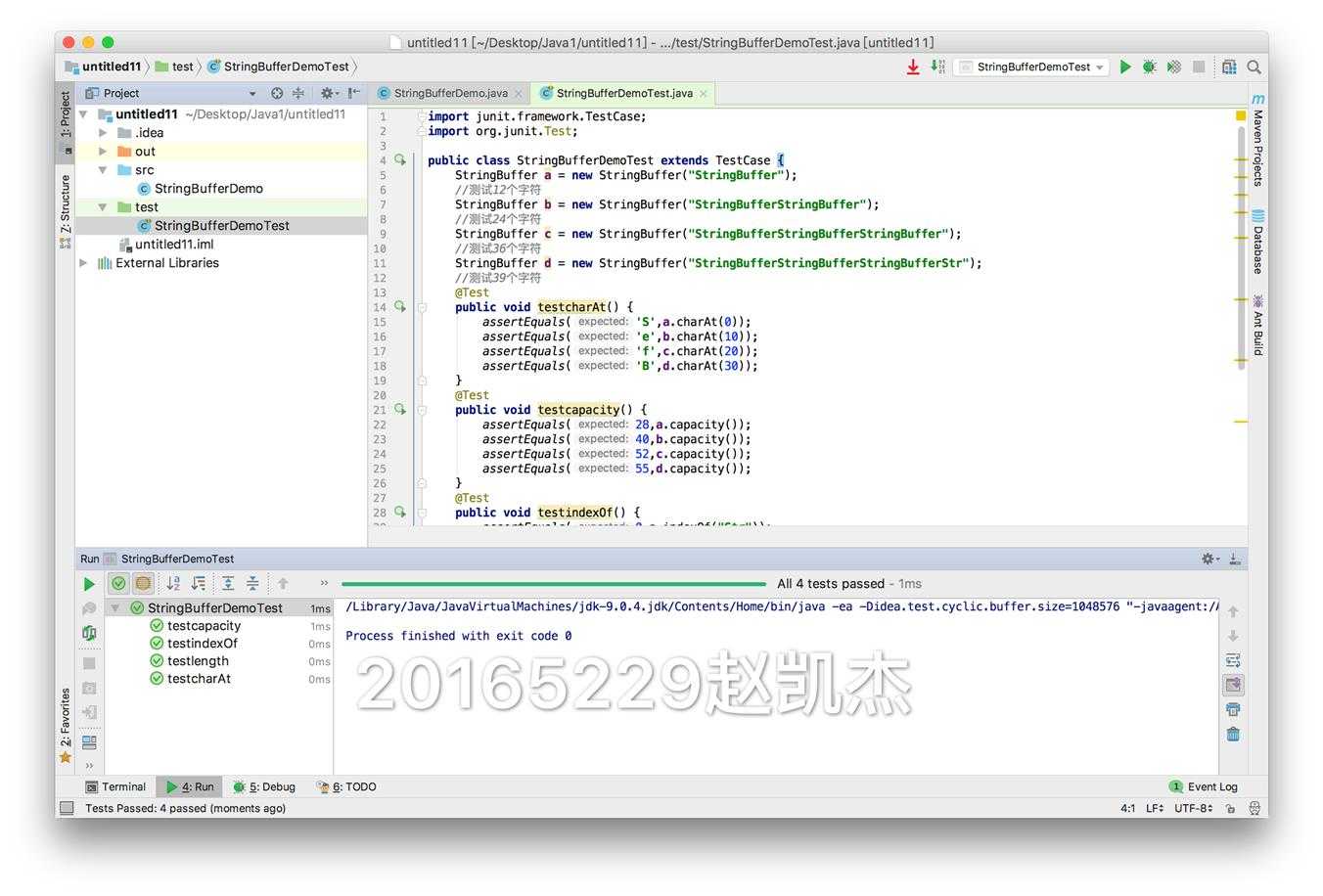
用自己的学号%6进行取余运算,根据结果进行代码扩充:
0:让系统支持Byte类,并在MyDoc类中添加测试代码表明添加正确,提交测试代码和运行结的截图,加上学号水印
1:让系统支持Short类,并在MyDoc类中添加测试代码表明添加正确,提交测试代码和运行结的截图,加上学号水印
2:让系统支持Boolean类,并在MyDoc类中添加测试代码表明添加正确,提交测试代码和运行结的截图,加上学号水印
3:让系统支持Long类,并在MyDoc类中添加测试代码表明添加正确,提交测试代码和运行结的截图,加上学号水印
4:让系统支持Float类,并在MyDoc类中添加测试代码表明添加正确,提交测试代码和运行结的截图,加上学号水印
5:让系统支持Double类,并在MyDoc类中添加测试代码表明添加正确,提交测试代码和运行结的截图,加上学号水印我是第5题:
实验代码让系统支持Double类,并在MyDoc类中添加测试代码表明添加正确
abstract class Data {
abstract public void DisplayValue();
}
class Integer extends Data {
int value;
Integer() {
value = 100;
}
@Override
public void DisplayValue() {
System.out.println(value);
}
}
class Double extends Data {
double value;
Double() {
value = 82.8;
}
@Override
public void DisplayValue() {
System.out.println(value);
}
}
abstract class Factory {
abstract public Data CreateDataObject();
}
class IntFactory extends Factory {
public Data CreateDataObject() {
return new Integer();
}
}
class DoubleFactory extends Factory {
public Data CreateDataObject() {
return new Double();
}
}
class Document {
Data pd;
Document(Factory pf) {
pd = pf.CreateDataObject();
}
public void DisplayData() {
pd.DisplayValue();
}
}
public class MyDoc {
static Document d, e;
public static void main(String[] args) {
d = new Document(new DoubleFactory());
e = new Document(new IntFactory());
e.DisplayData();
d.DisplayData();
}
}
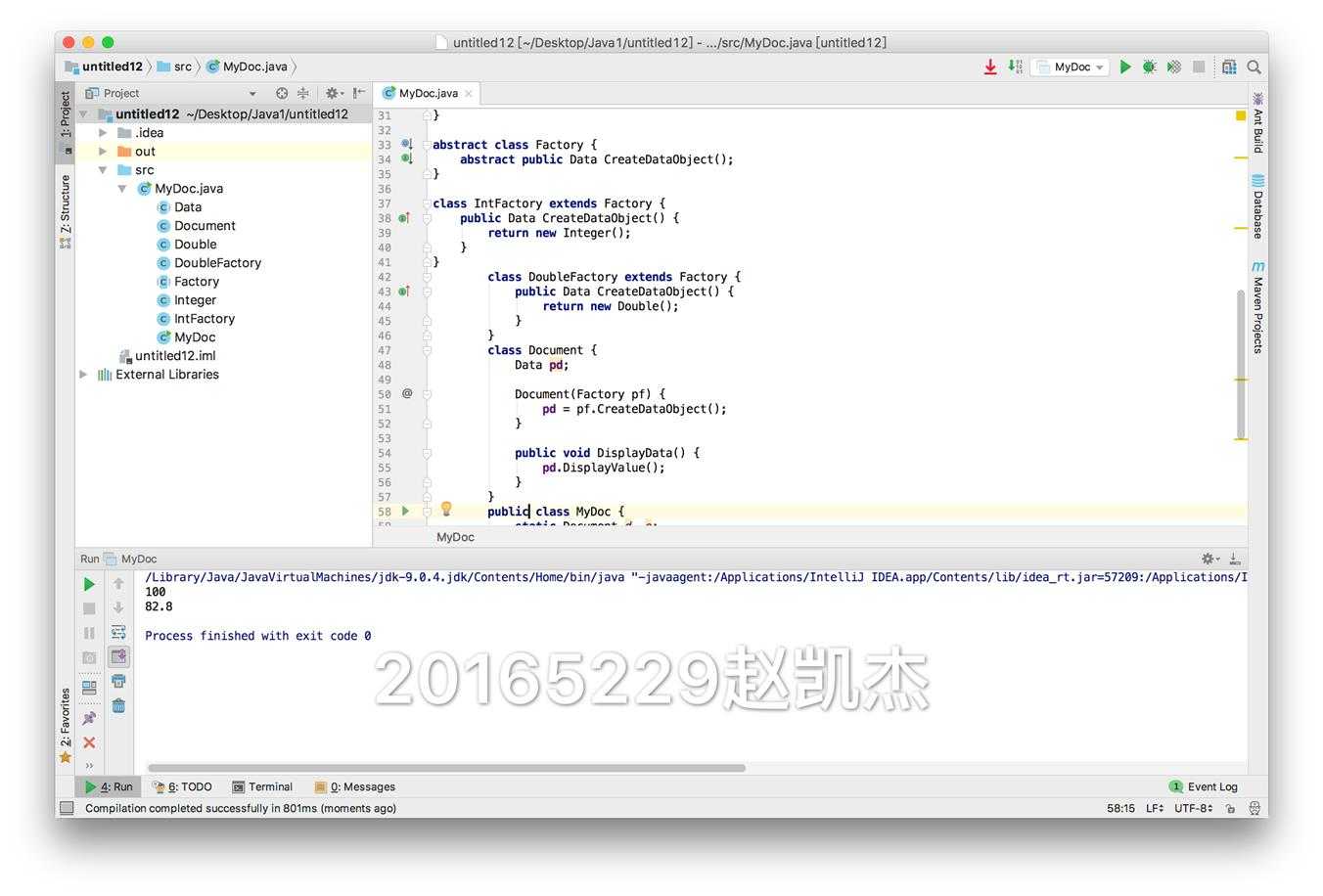
提交:单元测试代码和运行成功截图及码云上代码链接,截图要加上学号水印
任务:以TDD的方式开发一个复数类Complex。
public class Complex {
private double r;
private double i;
public Complex(double r, double i) {
this.r = r;
this.i = i;
}
public static double getRealPart(double r) {
return r;
}
public static double getImagePart(double i) {
return i;
}
public Complex ComplexAdd(Complex c) {
return new Complex(r + c.r, i + c.i);
}
public Complex ComplexSub(Complex c) {
return new Complex(r - c.r, i - c.i);
}
public Complex ComplexMulti(Complex c) {
return new Complex(r * c.r - i * c.i, r * c.i + i * c.r);
}
public Complex ComplexDiv(Complex c) {
return new Complex((r * c.i + i * c.r) / (c.i * c.i + c.r * c.r), (i * c.i + r * c.r) / (c.i * c.i + c.r * c.r));
}
public String toString() {
String s = " ";
if (i > 0)
s = r + "+" + i + "i";
if (i == 0)
s = r + "";
if (i < 0)
s = r + " " + i + "i";
return s;
}
}
import junit.framework.TestCase;
import org.junit.Test;
public class ComplexTest extends TestCase {
Complex a = new Complex( 0,3);
Complex b= new Complex( -1,-1);
@Test
public void testComplexAdd () throws Exception {
assertEquals( "-1.0+2.0i",a.ComplexAdd(b).toString());
}
@Test
public void testComplexSub () throws Exception{
assertEquals( "1.0+4.0i",a.ComplexSub(b).toString());
}
@Test
public void testComplexMulti () throws Exception {
assertEquals( "3.0 -3.0i",a.ComplexMulti(b).toString());
}
@Test
public void testComplexDiv () throws Exception {
assertEquals( "-1.5 -1.5i",a.ComplexDiv(b).toString());
}
}
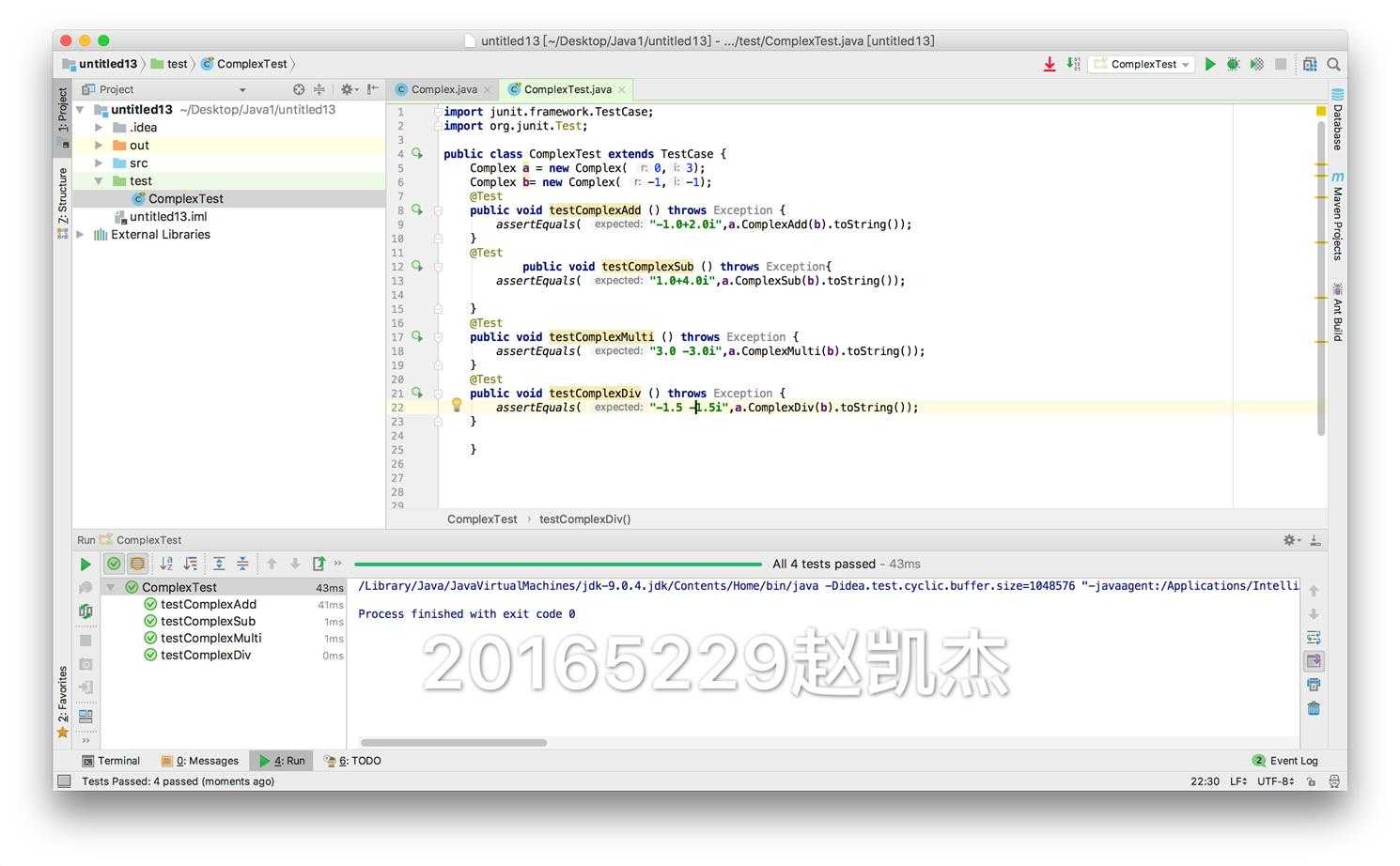
使用StarUML对实验二中的代码进行建模
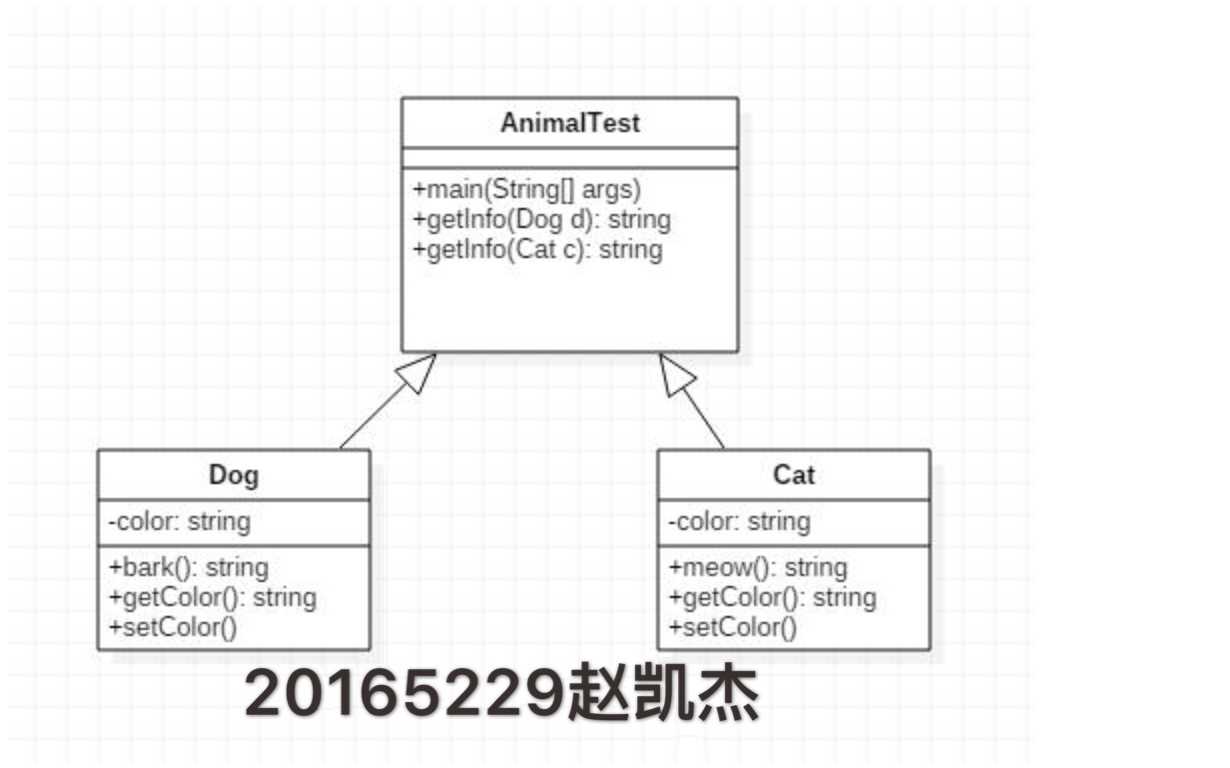
本次实验我感觉到了java学习的困难,因为使用的是mac电脑,有些步骤和老师所给的教程不一样,通过自己查教程一步一步完成了实验,感觉很有成就感。在本次实验中我了解了伪代码 产品代码 测试代码 三种的区别,并且学会了在idea中运用Juint测试代码。
20165229实验二 《Java面向对象程序设计》实验报告
标签:test ringbuf cep 支持 integer info extends bool ted
原文地址:https://www.cnblogs.com/zkkj/p/8855429.html